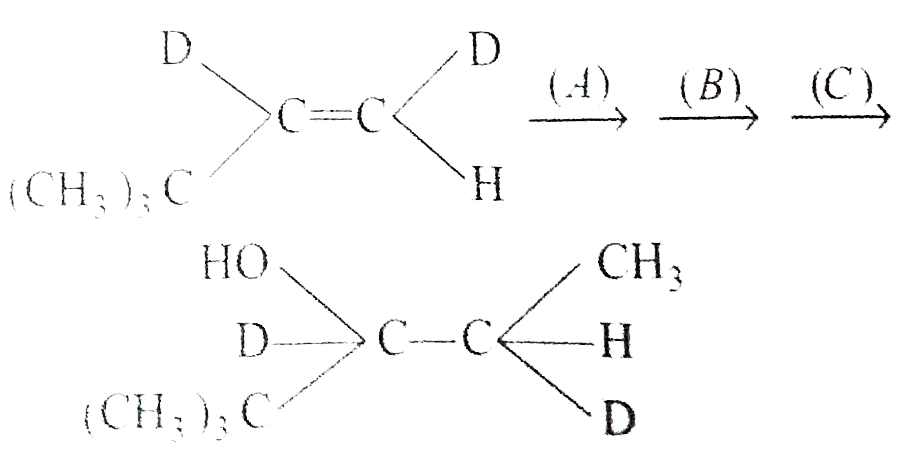CH3CH2OHcocn.H2SO4−−−−−−−→413KA'A will be:
CH2=CH2
C2H5OCH3
(C2H5)2O
CH3CH2CH2CH3
The correct Answer is:C
To solve the question CH₃CH₂OHcocn.H₂SO₄−−−−−−−−→413KA'A, we need to analyze the reaction of ethanol (CH₃CH₂OH) with concentrated sulfuric acid (H₂SO₄) at a temperature of 413 K.
1. Identify the Reactants:
The reactant is ethanol (CH₃CH₂OH), and we are using concentrated sulfuric acid (H₂SO₄) as a catalyst.
2. Understand the Reaction Conditions:
The temperature given is 413 K. This temperature is crucial because it determines the pathway of the reaction. At lower temperatures (like 413 K), the reaction favors the formation of ethers rather than alkenes.
3. Protonation of Alcohol:
When ethanol is mixed with concentrated sulfuric acid, the first step is the protonation of the hydroxyl group (-OH) of ethanol. The sulfuric acid donates a proton (H⁺) to the oxygen atom in the hydroxyl group, forming an oxonium ion (CH₃CH₂OH₂⁺).
4. Formation of Carbocation:
The protonated ethanol (oxonium ion) is unstable and can lose a water molecule (H₂O), leading to the formation of a carbocation (CH₃CH₂⁺).
5. Nucleophilic Attack:
At 413 K, instead of elimination to form an alkene, the carbocation can react with another ethanol molecule. The ethyl group (CH₃CH₂) acts as a nucleophile and attacks the positively charged oxygen of the carbocation.
6. Formation of Ether:
The resulting product from this nucleophilic attack is diethyl ether (CH₃CH₂OCH₂CH₃). This is because the nucleophile (ethanol) donates a pair of electrons to bond with the carbocation, resulting in the formation of an ether.
7. Final Product:
Therefore, the final product A'A is diethyl ether (CH₃CH₂OCH₂CH₃).
Conclusion:
The reaction of ethanol with concentrated sulfuric acid at 413 K leads to the formation of diethyl ether (CH₃CH₂OCH₂CH₃).
Answer:
The product A'A will be diethyl ether (CH₃CH₂OCH₂CH₃).
---
The reactant is ethanol (CH₃CH₂OH), and we are using concentrated sulfuric acid (H₂SO₄) as a catalyst.
The temperature given is 413 K. This temperature is crucial because it determines the pathway of the reaction. At lower temperatures (like 413 K), the reaction favors the formation of ethers rather than alkenes.
When ethanol is mixed with concentrated sulfuric acid, the first step is the protonation of the hydroxyl group (-OH) of ethanol. The sulfuric acid donates a proton (H⁺) to the oxygen atom in the hydroxyl group, forming an oxonium ion (CH₃CH₂OH₂⁺).
The protonated ethanol (oxonium ion) is unstable and can lose a water molecule (H₂O), leading to the formation of a carbocation (CH₃CH₂⁺).
At 413 K, instead of elimination to form an alkene, the carbocation can react with another ethanol molecule. The ethyl group (CH₃CH₂) acts as a nucleophile and attacks the positively charged oxygen of the carbocation.
The resulting product from this nucleophilic attack is diethyl ether (CH₃CH₂OCH₂CH₃). This is because the nucleophile (ethanol) donates a pair of electrons to bond with the carbocation, resulting in the formation of an ether.
Therefore, the final product A'A is diethyl ether (CH₃CH₂OCH₂CH₃).
The reaction of ethanol with concentrated sulfuric acid at 413 K leads to the formation of diethyl ether (CH₃CH₂OCH₂CH₃).
The product A'A will be diethyl ether (CH₃CH₂OCH₂CH₃).
Topper's Solved these Questions
- ALCOHOLS, PHENOLS AND ETHERSBook:MODERN PUBLICATIONChapter:ALCOHOLS, PHENOLS AND ETHERSExercise:Revision Exercises I (Passage Based Questions)
Explore 5 Videos
- ALCOHOLS, PHENOLS AND ETHERSBook:MODERN PUBLICATIONChapter:ALCOHOLS, PHENOLS AND ETHERSExercise:Revision Exercises II (Passage Based Questions)
Explore 5 Videos
- ALCOHOLS, PHENOLS AND ETHERSBook:MODERN PUBLICATIONChapter:ALCOHOLS, PHENOLS AND ETHERSExercise:QUICE MEMORY TEST (accelerate your potential for objective questions ) C (Choose the correct alternative).
Explore 12 Videos
- ALDEHYDES ,KETONES AND CARBOXYLIC ACIDSBook:MODERN PUBLICATIONChapter:ALDEHYDES ,KETONES AND CARBOXYLIC ACIDSExercise:UNIT PRACTICE TEST
Explore 13 Videos
Similar Questions
Write the mechanism of the following reaction :
2CH3CH2OhConc. H2SO4−−−−−−−−→413KCH3CH2−O−CH2−CH3
View SolutionPredict the products:
(i) CH3CH2OHK2Cr2O7−−−−−→H2SO4ASOCl2−−−→BNH2−−→CNaOBr−−−→D
(ii) CH3CH2ClKCN−−→AOH−−−→H2O2BP2O5−−→C
(iii) CH3COOHC2H5OH−−−−−−→concH2SO4ACH3MgBr−−−−−→H+/H2OBCH3MgBr−−−−−→H2∅H+C
View Solution
Knowledge Check
C2H5OHConc. H2SO4−−−−−−−−→413KA,A will be :
ACH2=CH2BC2H5OCH3C(C2H5)2ODCH3CH2CH2CH3.CH3−CH2−OHH2SO4−−−→413KX, What is X ?
ACH2=CH2BC2H5−O−C2H5CCH3−O−CH2−CH3DCH3CH2HSO4In this reaction , (CH3)3C−CH2OHConc.H2SO4−−−−−−−−→170∘CX
X isA(CH3)2C=CHCH3BCH3≡CHC(CH3)2CHCH2CH3DCH3−CH2−C∣CH3=CH2
CH3−CH3∣C∣CH3−CH2−OHconc.H2SO4−−−−−−−→ΔP
The product P is
View SolutionComplete the following equations:
a) H2C=CH−CH3+HCl→(A)
b) CH3−CH=C(CH3)2+O3Zn−−→H2O(A)+(B)
c) H2C=CH2+O3H2O−−→(A)NaOH(aq)−−−−−−→(B)+(C)
d) (CH3)3C−CH=CH2+HC<o(A)
d) MeCH2C≡CHNaNH2−−−−→(A)Et.Br−−−→(B)
g) HC≡CHH2,Pd(CaCO3)−−−−−−−−−−→(CH3COO)2Pb(A)Br2−−→Cl4(B)KOH(alc)−−−−−−→(C)
h) HC≡CHHgSO4,H2O−−−−−−−→H2SO4(A)H−−−→LiAlH4(B)concH2SO4−−−−−−→443K(C)
i) CH3CH=(CH2)Br2A773KCl2−−→773K(B)
j) CH3CH=CH2Br2−−→773K(A)KOH(alc)−−−−−−→Δ(B)
k) H2C=CH2+CH2+CH2→(A)
l) CH3CH=CH2+CH2I2→(A)
m) H2C=CH−CH=CH2+H2=CH2→(A)H2−−→Pd(B)
n) C3H7CH=CH2Hg(OAc)2−−−−−−→THF/H2O(A)NaBH4/NaOH−−−−−−−−−→(B)
o) CH3CH=CH2BH3/THF−−−−−−→(A)CH3COOH−−−−−−→(B)
p) C6H5CH=CH2Br2−−→(A)3.0equiv−−−−→CH3I(B)
q) C6H5CH2CH(Cl)C6H5KOH(alc)−−−−−−→Δ(A)
r)

View SolutionConsider the given reaction
CH3−CH3∣C∣CH3−CH2−OHconc.H2SO4−−−−−−→ΔAlkene(major)
Identify alkene.
View SolutionConsider the following reaction sequence ,
CH3CH(OH)CH3ConcH2SO4−−−−−−−−→HeatXdil.H2SO4−−−−−−−−→H2OY
X and Y in the reaction respectively are
View SolutionCH3CH2CH2OHconc. H2SO4−−−−−−−−→170∘CACl2−−−→500∘CB.
A and B. are
View Solution